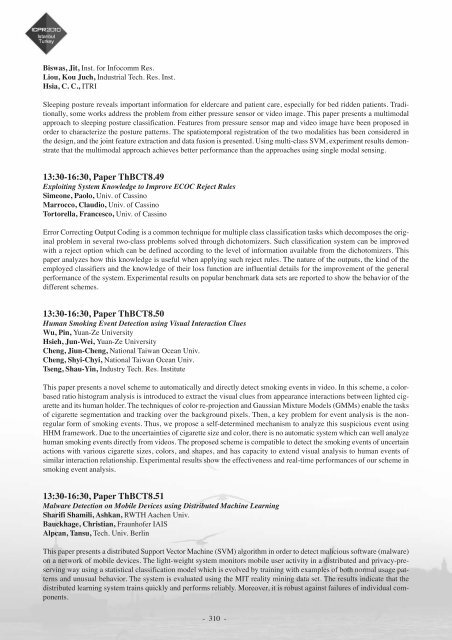Abstract book (pdf) - ICPR 2010
Abstract book (pdf) - ICPR 2010
Abstract book (pdf) - ICPR 2010
- TAGS
- abstract
- icpr
- icpr2010.org
You also want an ePaper? Increase the reach of your titles
YUMPU automatically turns print PDFs into web optimized ePapers that Google loves.
Biswas, Jit, Inst. for Infocomm Res.<br />
Liou, Kou Juch, Industrial Tech. Res. Inst.<br />
Hsia, C. C., ITRI<br />
Sleeping posture reveals important information for eldercare and patient care, especially for bed ridden patients. Traditionally,<br />
some works address the problem from either pressure sensor or video image. This paper presents a multimodal<br />
approach to sleeping posture classification. Features from pressure sensor map and video image have been proposed in<br />
order to characterize the posture patterns. The spatiotemporal registration of the two modalities has been considered in<br />
the design, and the joint feature extraction and data fusion is presented. Using multi-class SVM, experiment results demonstrate<br />
that the multimodal approach achieves better performance than the approaches using single modal sensing.<br />
13:30-16:30, Paper ThBCT8.49<br />
Exploiting System Knowledge to Improve ECOC Reject Rules<br />
Simeone, Paolo, Univ. of Cassino<br />
Marrocco, Claudio, Univ. of Cassino<br />
Tortorella, Francesco, Univ. of Cassino<br />
Error Correcting Output Coding is a common technique for multiple class classification tasks which decomposes the original<br />
problem in several two-class problems solved through dichotomizers. Such classification system can be improved<br />
with a reject option which can be defined according to the level of information available from the dichotomizers. This<br />
paper analyzes how this knowledge is useful when applying such reject rules. The nature of the outputs, the kind of the<br />
employed classifiers and the knowledge of their loss function are influential details for the improvement of the general<br />
performance of the system. Experimental results on popular benchmark data sets are reported to show the behavior of the<br />
different schemes.<br />
13:30-16:30, Paper ThBCT8.50<br />
Human Smoking Event Detection using Visual Interaction Clues<br />
Wu, Pin, Yuan-Ze University<br />
Hsieh, Jun-Wei, Yuan-Ze University<br />
Cheng, Jiun-Cheng, National Taiwan Ocean Univ.<br />
Cheng, Shyi-Chyi, National Taiwan Ocean Univ.<br />
Tseng, Shau-Yin, Industry Tech. Res. Institute<br />
This paper presents a novel scheme to automatically and directly detect smoking events in video. In this scheme, a colorbased<br />
ratio histogram analysis is introduced to extract the visual clues from appearance interactions between lighted cigarette<br />
and its human holder. The techniques of color re-projection and Gaussian Mixture Models (GMMs) enable the tasks<br />
of cigarette segmentation and tracking over the background pixels. Then, a key problem for event analysis is the nonregular<br />
form of smoking events. Thus, we propose a self-determined mechanism to analyze this suspicious event using<br />
HHM framework. Due to the uncertainties of cigarette size and color, there is no automatic system which can well analyze<br />
human smoking events directly from videos. The proposed scheme is compatible to detect the smoking events of uncertain<br />
actions with various cigarette sizes, colors, and shapes, and has capacity to extend visual analysis to human events of<br />
similar interaction relationship. Experimental results show the effectiveness and real-time performances of our scheme in<br />
smoking event analysis.<br />
13:30-16:30, Paper ThBCT8.51<br />
Malware Detection on Mobile Devices using Distributed Machine Learning<br />
Sharifi Shamili, Ashkan, RWTH Aachen Univ.<br />
Bauckhage, Christian, Fraunhofer IAIS<br />
Alpcan, Tansu, Tech. Univ. Berlin<br />
This paper presents a distributed Support Vector Machine (SVM) algorithm in order to detect malicious software (malware)<br />
on a network of mobile devices. The light-weight system monitors mobile user activity in a distributed and privacy-preserving<br />
way using a statistical classification model which is evolved by training with examples of both normal usage patterns<br />
and unusual behavior. The system is evaluated using the MIT reality mining data set. The results indicate that the<br />
distributed learning system trains quickly and performs reliably. Moreover, it is robust against failures of individual components.<br />
- 310 -



